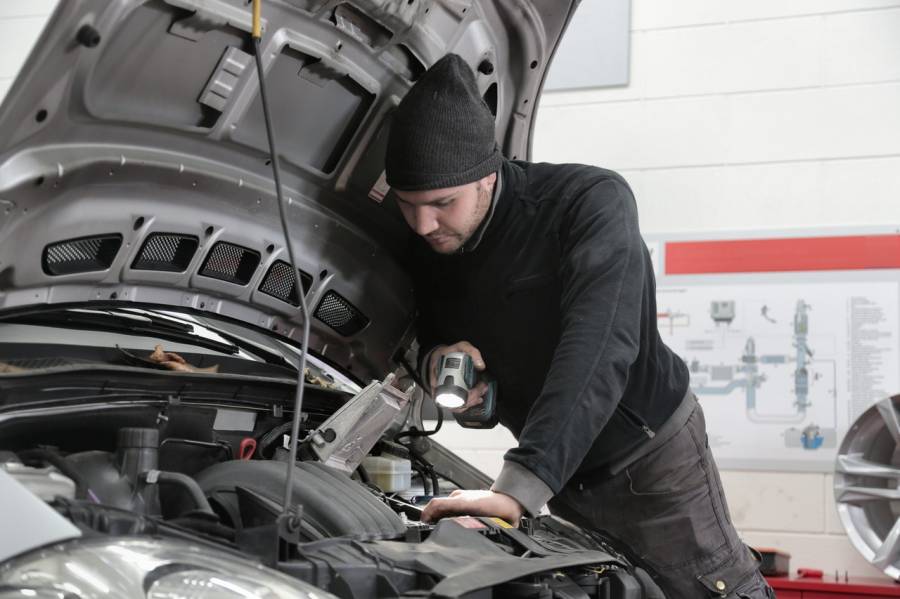Quick Navigation
A radiator fan dissipates heat generated by the car’s engine and controls the engine’s temperature regulation. In the optimum state, it switches on and off sporadically.
If the engine becomes too heated, the radiator fan is turned on to cool it down, after which it is turned off automatically so that the engine can return to its normal state.

It constantly happens whether the vehicle is moving or static. However, the radiator fan system could quickly become faulty, turning on and off at the wrong intervals.
The common causes of this error and their solution are outlined below.
Causes And Solution
When The Thermodynamic Loop Has Problems
The radiator fan regulates the engine’s heating when airflow is limited in the vehicle. The cooling effect is known as the thermodynamic loop.
Usually, the heat generation rate of a car at rest is below that for maintaining the refrigerant flow into the reservoir.
But the temperature fluctuates according to the refrigerant levels in the reservoir and the car’s motion.
During poor airflow within the engine, the radiator fan maintains the coolant within a specific temperature range.
Solution
Consult a mechanic who will check the thermostat and all the heating systems to ascertain the origin of the problems.
When The Fan Control Module Is Bad
If a car has a different radiator fan control module, it is usually located at the engine bay. Harsh environmental conditions will affect it.
It would lead to wear and rusting of the module.
Solution
Examine the relay for physical damages on the exterior. Look at the interior for wear and tear or poor soldering.
These may be fixed by repairing and then soldering if applicable. In severe cases, the module may need to be replaced.
When The Thermostat Is Bad
The thermostat serves to maintain the usefulness of the radiator fan. The thermostat also regulates engine water levels.
The inner frozen part and the exterior of the spring of the thermostat are liable to damage.
Such damages could lead to ant freezing by redirecting the radiator fan circulation.
When the thermostat develops a problem, there is a change in the cooling effect concerning variation in heating.
Solution
Fixing a car thermostat is a simple and affordable repair. It will usually solve an overheating, saving the energy/cost required for specialist diagnosis.
Once you update your car’s air conditioning system, it’s a good idea to change the thermostat.
As a result, inspect the thermostat and replace it whenever you update your car’s air conditioner or heater.
If your automobile exhibits poor car thermostat symptoms, replace it as soon as feasible. Also, fix the thermostat sensor.
It may return the functioning of the thermostat to normal.
When The Fuses Are Blown
A fuse protects practically every electrical component in an automobile.
If an electrical shock strikes a piece of digital hardware, the fuse shuts the power to that piece of equipment, preventing it from being destroyed. It is referred to as a blown fuse.
Solution
A blown fuse isn’t a huge problem, and replacing one isn’t expensive. Look in the owner’s manual for the fuse for the radiator fan controller or the fan.
When The Coolant Temperature Sensor Is Faulty
Some cars’ radiator fan is controlled by a separate fan control module rather than the engine control system.
A faulty coolant temperature sensor will indicate a cold signal consistently. This status activates the radiator fan.
Solution
Using the car’s service manual as a guide, check the particular type of control for the radiator fan. Examine and confirm the functionality of the sensor using a multimeter.
It is best to consult your mechanic. However, check your service handbook to see which temperature sensor controls the radiator fan.
Resistance-measure the sensor using a multimeter to confirm it is working correctly.
When There Is A Broken Wire Or Connection
Erratic turning on and off of the fan could be from disconnected wires.
Solution
Inspect the wiring at the control units and the switch level. Also, check the plugs for signs of wear.
A mechanic will need to measure the cabling with a multimeter to ascertain the flow of electricity. Then fix the source of the disconnection.

When The Coolant Levels Drop Below A Limit
Low levels of coolants will cause overheating of the engine. The radiator fan will turn on to cool the engine again.
It dissipates the generated heat to maintain the engine temperature at normal. But coolant levels below a cut-off point will hamper the radiator fan functions.
Solution
Always check the coolant level for depletion. You may need to top up or replace the coolant entirely.
When The Filters Become Clogged
Clogged air filters will lead to overheating from airflow restriction in the engine, thus turning the radiator fan on and off to return the temperature to normal.
Solution
Consult a mechanic to de-clog the filters or replace them.
When The Radiator Fan Belt Becomes Broken
Sometimes the fan belt may cut, loosen up or slag off completely. Snapped belt problem will prevent the cycling of the fan.
No cycling means excessive heating from poor air circulation. This scenario can trigger the radiator fan to tick on and off uncontrollably.
Solution
Replace the belt.
When The A/C Compressor Is Engaged
The radiator fan could be triggered when the AC compressor is engaged.
The radiator fan circulates air within the AC condenser to overcome overheating and enhance the functioning of the car’s AC.
However, this varies with the type of cars and engine radiator fans. Smaller cars have fewer radiator fans, while some have more.
Cars with one radiator fan may need to have the radiator fan constantly on to maintain the AC functioning.
Without the radiator fan turned on, the AC may not dissipate all the heat generated.
Moreover, because of the smaller size and location of the AC condenser, the cooling effect is rendered suboptimal.
This attribute of car AC is even independent of the motion status of the car. The same principle of operation applies to both moving and static cars.
Note that the heat circulation in the AC set-up is almost stable and unchanging in different temperatures. Therefore radiator fan serves to cool the AC.
When The Electronic Control Unit (ECU) Is Faulty
ECU is the electronic powerhouse of the car’s engine. It regulates the electrical system of a car to ensure smooth operations of the electrical aspects of the car.
Abnormality in the ECU can trigger the radiator fan to turn on and off uncontrollably. It is because the ECU moderates the function of the radiator fan.
It takes skills and expertise to link radiator fan turning on and off to ECU problems.
Solution
The solution is to repair or replace the ECU. The parts and repair of ECU are expensive, but they are worthwhile rather than a total replacement, which is capital intensive.
Getting an expert to repair or reprogram the ECU may be a challenge as there are fewer skilled professionals in the area. But nowadays, some mechanics offer online repair services.
You may contact an expert through this means. You send the ECU to their workshop.
They fix it and send it back to you without the need for your physical presence.
When The Cooling Fan Switch Is Faulty
The cooling fan switch is the toggle part that ticks on or off to regulate the cooling effects. Damage to the cooling fan switch could lead to radiator fan activation.
Solution
Replace the cooling fan switch. First, go to the car’s hood, open it, and check the fan system.
The cooling fan switch is found on the uppermost left side of the fan, with two wires. Disconnect the wires and detach the switch.
Then replace it with the new one while reversibly following the steps taken to remove it. However, it is best to consult an expert mechanic.
The mechanic will carefully remove the damaged cooling fan switch and install a new one.
A professional mainly possess the skill of connecting the two wires correctly in the switch.
Other Solutions
To ensure the radiator fan runs continuously without errors, you may need to control its operations manually. It is done by connecting a manual switch to the fan.
The manual switch should not be located at the battery connection but on the ignition switch side. It will make the fan turn off when the ignition is turned off.
However, fixing the manual switch may mean continuous running of the fan against ignition. It is because the thermostat controls the water temperature.
Fixing the radiator fan turning on and off is best done by the mechanic. They are trained to diagnose the cause of the errors and fix them appropriately.
Conclusion
Generally, the radiator fan turns on and off constantly because the engine is trying to maintain a specific temperature.
When the engine gets too hot, the radiator fan comes on to cool it down. When the engine gets too cold, the radiator fan comes on to warm it up.
But this operational mode can become erratic. The fan may turn on and off when it should be vice versa.
The causes of this error are well-known but should be diagnosed accurately. Finding the cause is equivalent to fixing it because the solutions are readily available.

With comprehensive experience in writing exceptional quality articles and blogs about cars and related stuff, Daniel is one of the finest bloggers and a hardcore car lover we have. He is an ASE certified technician with an across-the-board experience of 10 years in the industry. He could not help tinkering with anything he got his hands on from a young age, which led to his remarkable career in the automotive repair industry.
When he is not under any hood, you can find him on the water or in the woods to pursue his passion for hunting and fishing. He has been writing for multiple sectors and is a regular contributor to several publications.
He currently owns a Nissan 300ZX TT and a Pearl Yellow but plans to upgrade it to 550 HP. His favorites include the Koenigsegg CCX and Lamborghini Diablo 6.0 VT, but for him, the Ferrari 360 Spider is one of the sexiest cars that exists to date.
Being an avid world traveler, he has spent most of his time analyzing the automotive markets, latest technology, and local favorites to enhance his knowledge base. He is currently living in North Caroline, where it’s all about food and coffee and, of course, cars.






![Tesla Model 3 Black Screen [Solved] Tesla Model 3 Black Screen [Solved]](https://carsupercare.com/wp-content/uploads/2023/02/Remote-Start-Flashing-Blue-Light–-What-to-Do-4-150x150.jpg)